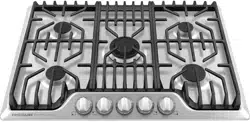Loading ...
Loading ...
Loading ...

7
SURFACE COOKWARE RECOMMENDATIONS
USE PROPER COOKWARE
Cookware should have at bottoms that make good
contact with the cooktop grate. Check for atness by
rotating a ruler across the bottom of the cookware (See
Figure 1). Be sure to follow the recommendations for
using cookware as shown in Figure 2.
Note: The size and type of cookware used will inuence
the setting needed for best cooking results.
Note: Always use a utensil for its intended purpose.
Follow manufacturer's instructions. Some utensils were
not made to be used in the oven or on the cooktop.
* Specialty pans such as lobster pots, griddles and
pressure cookers may be used but must conform to the
above recommended cookware requirements.
CORRECT
• Flat bottom and straight
sides.
• Tight tting lids.
• Weight of handle does
not tilt pan. Pan is well
balanced.
• Pan sizes match the
amount of food to be
prepared.
• Made of material that
conducts heat well.
• Easy to clean.
INCORRECT
• Curved and warped pan
bottoms.
• Pan overhangs unit by more
than 2.5 cm (1”).
• Heavy handle tilts pan.
• Flame extends beyond unit.
Figure 2
Figure 1
COOKWARE MATERIAL TYPES
The cookware material determines how evenly and
quickly heat is transferred from the surface unit to the
pan bottom. The most popular materials available are:
ALUMINUM - Excellent heat conductor. Some types
of food will cause it to darken (Anodized aluminum
cookware resists staining & pitting).
COPPER - Excellent heat conductor but discolors easily.
STAINLESS STEEL - Slow heat conductor with uneven
cooking results. Is durable, easy to clean and resists
staining.
CAST IRON - A poor heat conductor however will retain
heat very well. Cooks evenly once cooking temperature is
reached.
PORCELAIN-ENAMEL on METAL - Heating
characteristics will vary depending on base material.
GLASS - Slow heat conductor.
Loading ...
Loading ...
Loading ...
